boiling bakelite
An odd title, I know, but it will make sense. Originally, our light switch plates were brown Bakelite. All but one of them was replaced during the last sixty years –mostly with this ugly large flat type. They haven’t been improved by smoke-induced yellowing.
Some are whiter, but still ugly. They all need to go. I’d happily source replacement originals for all of them (plenty on eBay) but Karen’s not so keen. And I get it. Brown Bakelite works on paneling (as intended) but doesn’t look its best on white or gray walls.
If we’d inherited all originals, I’d fight my corner. We didn’t. But while we only retained one original switch plate, we do have several outlet covers. Sadly, they’ve all been painted, but this post gave me hope of rescuing them (thanks Olivia!) –I’ll get to that in a sec.
First, I’ll explain the compromise Karen and I reached. We decided to only install the Bakelite covers on our restored wood paneling. Gray walls, like this internal siding, get gray outlet covers. While the color doesn’t match, we like the look.
Walls we’ve painted white (like this one, in our master bedroom) get minimal, plain white covers, with small toggle-style switches. These look clean and modern, and are somewhat sympathetic (we think) to the original design.
We also inherited a couple of ceramic switch plates –the double below, and a matching single. Though not original, they are old. And we kinda like them. These will remain (for now, at least) on the large white wall in our dining area.
So, to the wood paneled walls. These are in our living room, office and master, and require six outlet covers and just one switch plate, which is lucky. I hope to restore more paneling eventually, and Karen’s sort of on-board. For now, that’s all we need.
The post I referenced earlier suggests boiling to remove paint from outlet covers. Having tried to scrape and scrub away paint, with limited success, I was open to anything. I boiled some water, and tentatively dropped one in.
I checked it every so often –salad tongs make the perfect tool for this. After about 20 minutes the paint softened enough to make removal easy. I did over-boil one (not pictured) causing significant fading. These three came out great.
And this was all we needed for the first phase of replacements. The two outlet covers would go on our master bedroom wall. These are for our DIY wall sconces and are very much on display. We had installed gray plates, but these look way better.
They work beautifully against the wood paneling, and contrast nicely with our blue cord. We bought standard brown duplex receptacles, from Home Depot –at first we thought these might be too glossy, but they look just fine.
The solo switch plate is for our office. This is wired to an outlet, designed to control a free-standing lamp. This has been out of action since we moved in so, from a practical standpoint, it’s great to have a light switch in here at all.
Even better, it looks exactly as intended. I know three covers isn’t a big deal, but it’s a good start. We need to strip four more outlet covers for the office and living room, then that will be it for a while. Hassle, but worth it don’t you think?

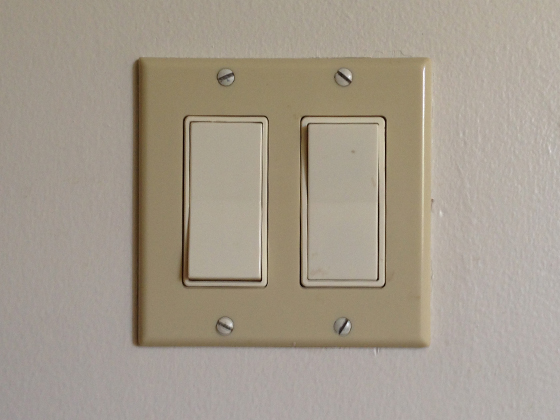
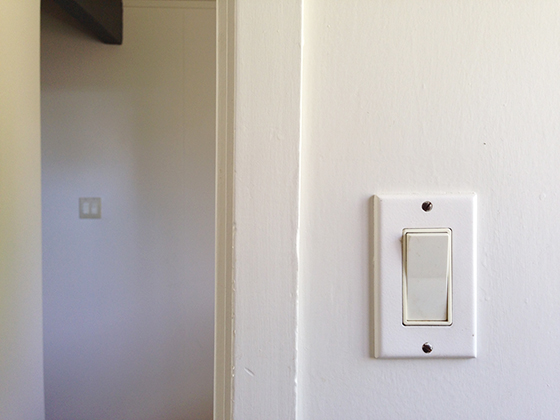

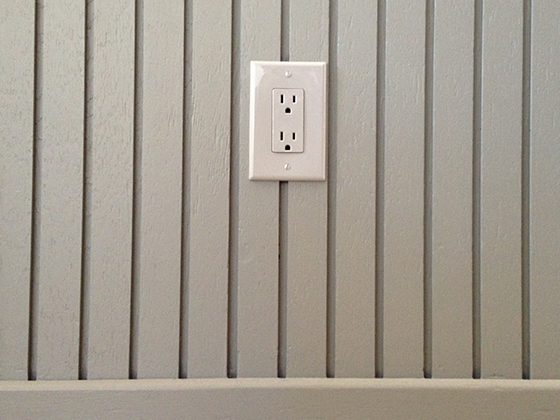
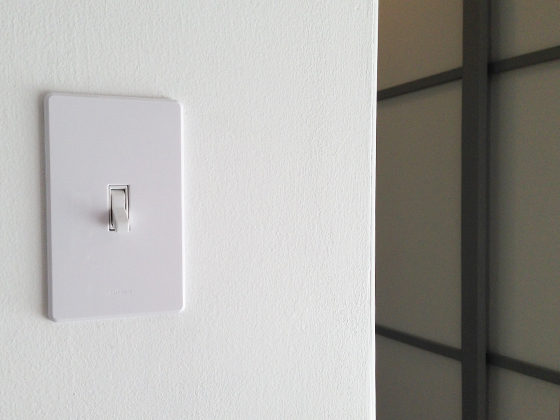
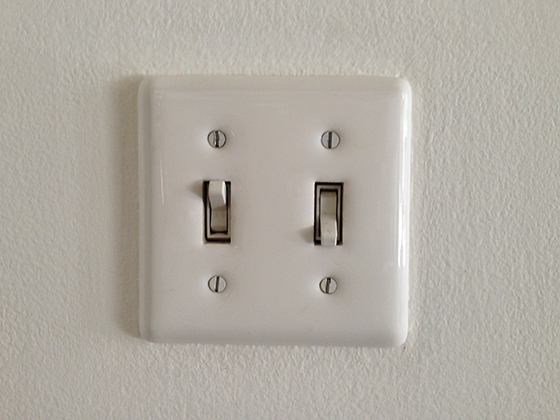
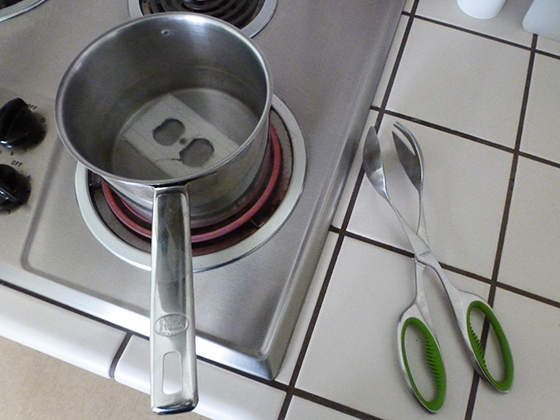

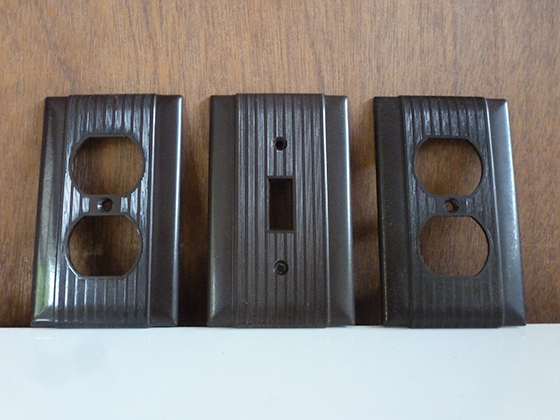

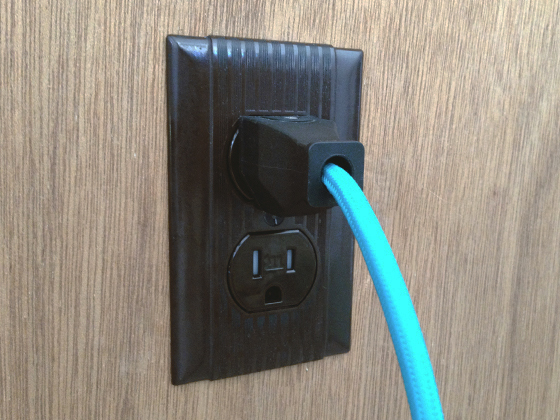
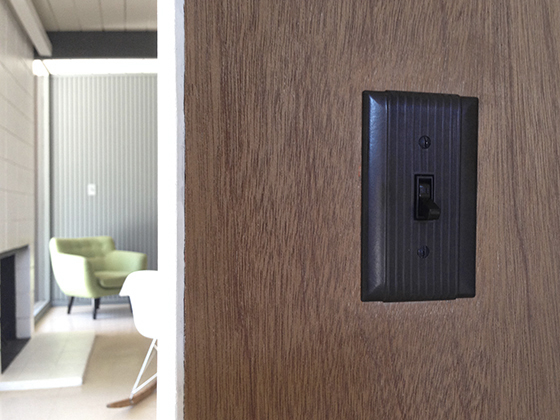
Olivia
Hey! Thanks for linking back. 🙂 You’re right, those brown covers look awesome on that wood wall — especially with that blue cord! I’m glad the boiling technique worked for you, too. Yours must have been painted with some serious paint though, I think I only had to boil mine for a few minutes!
fogmodern
You are welcome! And thanks. You know, I did this so long ago, I couldn’t remember how long it took. Thinking about it, 20 minutes is probably more accurate, so I’ve edited the post. Still a long time though. I think they’d been painted several times. I may leave one with paint stripper on and see how that works.
Julie
They look great! I especially like the plain white one around the middle – so clean and simple. I recently came across your blog and like watching your progress. We have a Streng home in the area.
Also, I must ask – where did you buy that cute green chair in the last photo? I’m in the market for some new living room furniture!
fogmodern
Hey Julie! Thanks, glad you like them. Cool you have a Streng –we’ve been in a few and love them. We bought the green chair a few years back, in England. Truthfully, it’s not our favorite but I like it from this angle. Thanks for stopping by! 🙂
Pingback: kitchen chaos « fogmodern
Pingback: hairpin table « fogmodern
Pingback: feature rich « fogmodern
Brian
WOW. i’ve been collecting vintage bakelite light switch/receptacle covers for a few years and have experimented multiple times with paint removal. so far, the best i had found was soaking them in easy off oven cleaner for a few hours, scrub with a tooth brush & warm water, then repeat until all the paint was gone. i still had to polish them when finished!
i really look forward to boiling them instead. thanks for the great idea!
one tip for your receptacles. home depot only carries the tamper resistant receptacles now which in my opinion, are difficult to plug in and look ugly.
canadian tire still sells the older style 3 prong receptacles that have been in use since the addition of the ground prong in the 1960s. they are more “rounded” like the old 2 prong receptacles and they do look nicer.
fogmodern
Hey Brian! If you do try this, be careful not to over-boil –I did this for one and lost some color/finish. Thanks for the receptacles tip –will check those out.
Brian
thanks for the tip. these old electrical pieces can be difficult to find so i certainly dont want to damage any.
despite being sick with the flu & recovering from surgery, i couldnt wait to try it so out came a painted 1930s receptacle. worked like a charm! i am stunned at how fast it worked. no more harsh chemicals and hours of scrubbing.
i recommend polishing bakelite with blue magic metal polish.
i was able to restore some shine to some plates pulled out of a schoolhouse that was boarded up in 1962.
i believe the blue magic formula might have been changed recently as i find my current jar of it doesnt shine them up as good as it used to but its still the best ive been able to find. its what all the vintage radio collectors use on their covers.
one more thing i should point out. bakelite does contain 15-17% asbestos. i spoke to a doctor who is a professional in asbestosis, mesothelioma and other asbestos cancers and i was told that the amount of exposure i was getting is not much of a concern. as long as there is no dust created and its not done on a day to day basis, i’m safe.
fogmodern
You are welcome, and so pleased the method worked for you. Thanks for the metal polish tip –will check that out also. And I didn’t realize there was asbestos in bakelite. Like you, I have minimal exposure, so I think we’re good. Worth knowing though, thanks. Oh, I hope you have a speedy recovery.
Brian
gotta save these old details some how!
i hope the blue magic works as well for you as it did for me.
as for the asbestos content, there are lots of things that contain asbestos that you’d never realize. lots of car parts made well into the 1970s contain asbestos. steering wheels, radio knobs, mirrors, seat belt buckle covers, distributor caps etc.
even old mattresses have asbestos in them!
fogmodern
Yep, we’re on the same page there. Thanks again for your input, Brian!
Lisa and Kyle
Neato!
fogmodern
Yeah, this worked out great. We’ve since sourced a couple more plates for other areas –eBay is great for that.
Pingback: paneling rescue | fogmodern
Pingback: music room | fogmodern
Cherry-Cherry Rastaberry
Totally awesome, I’ve cleaned up bakelite table taps and receptacle/switch covers before, but I just used hot water from the tap, tooth brush, and laundry detergent (although it also removes some of the gloss). If I were to use our range to boil those, though… I’m afraid I’d botch that quite badly! I’m so very glad to see there are people with an appreciation for the old outlet (so to speak) covers.
– Cherry’s DIY
Andy
Hey! Thanks for this. Seems we are kindred spirits 🙂 On reflection, boiling water does seem like overkill but everything worked out so all good. Thanks for stopping by!